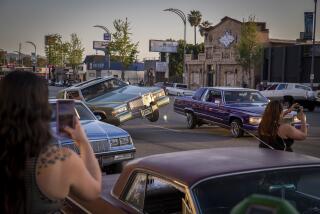Raising the Vehicle--and Safety Issues
- Share via
Ever cruise alongside a super-modified pickup truck or sport-utility vehicle that looks like it belongs at a tractor pull?
It can be intimidating. Their tires are the size of a Volkswagen Beetle, and some of these vehicles are elevated so high that it’s like sharing the road with a Boeing 747.
A reader recently drew our attention to the growing popularity and risks involving these vehicles.
Imagine yourself being rear-ended by one, suggested D.W. of Morro Bay: “Clearly, it would run right over your normal car. Why do law enforcement agencies continue to ignore these dangerous vehicles, and why are they licensed to operate on our highways?”
First of all, I don’t want to imagine being hit by one of these vehicles. The bumpers on these off-road-style vehicles certainly won’t match up to those on my station wagon. And as D.W. points out, they could steamroll right over most cars.
Second, law enforcers do take the safety of these vehicles seriously. California Highway Patrol Sgt. Rhett Price insists that his department is not ignoring modified vehicles that are illegal and unsafe.
“There are a lot of modified vehicles on the highways . . . and we are very good at enforcing the laws” regarding trucks and cars that have been altered, he said. “It’s a matter of safety.”
*
If the vehicles don’t meet legal requirements, the drivers can be cited for unsafe equipment, an infraction that carries a fine. The driver would also be ordered to fix or change the equipment. And if the vehicle is deemed to be extremely unsafe, the officer could even prohibit the vehicle from being driven away, Price said.
As the number of pickups and SUVs on the road is increasing, so seems to be the popularity of modifying these vehicles.
Whether drivers are raising or lowering their vehicles’ suspensions, or adding tubular bumpers and oversized tires, they’re personalizing their vehicles and trying to make a statement.
Say you’re a city slicker whose Dakota truck has never left paved streets and never carried anything other than groceries. You want the image of a rugged, adventurous off-road kind of guy who braves through mud and snow and blazes over rutted, rocky trails.
Depending on how aggressive a vehicle and image you want, you can spend $2,000 to $10,000 to modify your truck and have it look tough enough to have raced across the Mojave Desert.
“It’s a styling statement,” said Christopher Horn, vice president of consumer affairs for SEMA, the Diamond Bar-based Specialty Equipment Market Assn. “Many off-road vehicles and the specialty equipment purchased for them never venture off paved streets and highways.”
To be sure, there are serious off-road enthusiasts who do buy lift kits and giant tires to equip their vehicles for heavy-duty outdoor adventures in places such as Baja California. The Baja pre-runners (the vehicles that scout the courses for off-road racing vehicles) have such allure that Toyota sells a Tacoma PreRunner pickup, Horn noted.
Insurers also pay special attention to these highly modified vehicles, said Stephanie Macadaan, Northern California Regional Manager of the Insurance Information Network of California.
“Modifications are mostly done for appearance or performance. Rarely are they done with safety in mind,” Macadaan said. Depending on the alterations, she said, “your liability rates could go up.”
If the tires are too big or the vehicle is so tall that the modifications affect its center of gravity, that can “compromise the safety of other vehicles and cause more damage” in an accident, she said.
Legal height requirements for vehicles vary from state to state. Some states do not regulate lift modifications at all, said Chris Kersting, executive vice president of SEMA.
California regulates height by imposing maximum limits measuring the distance from the ground to the frame of the vehicle. The limit for most passenger vehicles is 23 inches. The limit goes up with the weight of the vehicle: 27 inches for vehicles up to 4,500 pounds, 30 inches for 4,501 to 7,500 pounds and 31 inches for 7,501 to 10,000 pounds.
The state sets the body lift limit at 5 inches. Since there is already a 1-inch space in vehicles when they come from the manufacturer, Kersting said, the vehicle may be lifted only 4 additional inches.
Nevertheless, some enthusiasts who want that extreme, rugged look for their vehicle are doing extreme modifications.
“I’ve seen some suspension lifts that go up to 12 to 14 inches” higher than the vehicles’ normal height, said Doug Schnetlage, sales manager of California Car Cover Co., an auto accessories catalog service in Chatsworth.
Some altered vehicles are so high that drivers “literally have to use a ladder to climb in,” Schnetlage said. “Seventy-five percent of these owners do it for appearance,” he said. Especially people in L.A.
*
Jeanne Wright cannot answer mail personally but responds in this column to automotive questions of general interest. Write to Your Wheels, Business Section, Los Angeles Times, Times Mirror Square, Los Angeles, CA 90053. E-mail: highway1@latimes.com.






